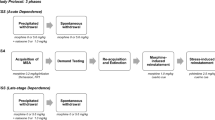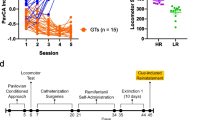Abstract
Rationale
Although chronic use of opiates can induce physical dependence and addiction, individual differences contributing to these symptoms are largely unknown.
Objectives
Using intravenous morphine self-administration (MSA), we investigated whether individual differences in drug intake are associated with weight change, acoustic startle reflex (ASR), pre-pulse inhibition (PPI), and drug seeking during spontaneous withdrawal.
Methods
Male Sprague-Dawley rats self-administered morphine (0.5 mg/kg/infusion) or saline for 3 weeks (4–6 h/day, 5 days/week) and drug intake and body weight were monitored daily. The ASR and the PPI (baseline, 1 day and 1 week) and drug seeking (1 week) were measured during spontaneous withdrawal.
Results
Morphine animals did not gain weight (101 % ± 0.69), while the control animals did (115 % ± 1.06) after 3 weeks of self-administration. The ASR and the PPI were not significantly different between morphine and saline animals in 1-day or 1-week withdrawal. However, individual differences in initial (first 10 min), but not total (4–6 h), morphine intake of the daily sessions were positively correlated with weight change (r = 0.437, p = 0.037) and drug seeking (r = 0.424, p = 0.035) while inversely correlated with the ASR (r = −0.544, p = 0.005) in 1-week withdrawal from chronic morphine.
Conclusions
A subgroup of animals that self-administered a larger amount of morphine at the beginning of the daily sessions exhibited subsequent weight gain, reduced ASR, and enhanced drug seeking in morphine withdrawal. Thus, individual differences in initial morphine intake may reveal a novel behavioral phenotype in opioid addiction.




Similar content being viewed by others
References
Aston-Jones G, Harris GC (2004) Brain substrates for increased drug seeking during protracted withdrawal. Neuropharmacology 47(Suppl 1):167–79
Blasig J, Herz A, Reinhold K, Zieglgansberger S (1973) Development of physical dependence on morphine in respect to time and dosage and quantification of the precipitated withdrawal syndrome in rats. Psychopharmacologia 33:19–38
Blaszczyk JW (2003) Startle response to short acoustic stimuli in rats. Acta Neurobiol Exp (Wars) 63:25–30
Buccafusco JJ, Bain JN (2007) A 24-h access I.V. self-administration schedule of morphine reinforcement and the estimation of recidivism: pharmacological modification by arecoline. Neuroscience 149:487–98
Butler RW, Braff DL, Rausch JL, Jenkins MA, Sprock J, Geyer MA (1990) Physiological evidence of exaggerated startle response in a subgroup of Vietnam veterans with combat-related PTSD. Am J Psychiatry 147:1308–12
Choi KH, Edwards S, Graham DL, Larson EB, Whisler KN, Simmons D, Friedman AK, Walsh JJ, Rahman Z, Monteggia LM, Eisch AJ, Neve RL, Nestler EJ, Han MH, Self DW (2011) Reinforcement-related regulation of AMPA glutamate receptor subunits in the ventral tegmental area enhances motivation for cocaine. J Neurosci 31:7927–37
Choi KH, Whisler K, Graham DL, Self DW (2006) Antisense-induced reduction in nucleus accumbens cyclic AMP response element binding protein attenuates cocaine reinforcement. Neuroscience 137:373–83
Crombag HS, Gorny G, Li Y, Kolb B, Robinson TE (2005) Opposite effects of amphetamine self-administration experience on dendritic spines in the medial and orbital prefrontal cortex. Cereb Cortex 15:341–8
Dai S, Corrigall WA, Coen KM, Kalant H (1989) Heroin self-administration by rats: influence of dose and physical dependence. Pharmacol Biochem Behav 32:1009–15
Davis M, Sheard MH (1975) Effects of lysergic acid diethylamide (LSD) on temporal recovery (pre-pulse inhibition) of the acoustic startle response in the rat. Pharmacol Biochem Behav 3:861–8
Davis M, Sollberger A (1971) Twenty-four hour periodicity of the startle response in rats. Psychon Sci 25:37–39
Davis M, Walker DL, Lee Y (1997) Roles of the amygdala and bed nucleus of the stria terminalis in fear and anxiety measured with the acoustic startle reflex. Possible relevance to PTSD. Ann N Y Acad Sci 821:305–31
Fleshler M (1965) Adequate acoustic stimulus for startle reaction in the rat. Journal of comparative and physiological psychology 60:200–7
Glick SD, Cox RS, Crane AM (1975) Changes in morphine self-administration and morphine dependence after lesions of the caudate nucleus in rats. Psychopharmacologia 41:219–24
Glick SD, Merski C, Steindorf S, Wang S, Keller RW, Carlson JN (1992) Neurochemical predisposition to self-administer morphine in rats. Brain Res 578:215–20
Gosnell BA, Lane KE, Bell SM, Krahn DD (1995) Intravenous morphine self-administration by rats with low versus high saccharin preferences. Psychopharmacology (Berl) 117:248–52
Hall BJ, Pearson LS, Terry AV Jr, Buccafusco JJ (2011) The use-dependent, nicotinic antagonist BTMPS reduces the adverse consequences of morphine self-administration in rats in an abstinence model of drug seeking. Neuropharmacology 61:798–806
Harris AC, Gewirtz JC (2004) Elevated startle during withdrawal from acute morphine: a model of opiate withdrawal and anxiety. Psychopharmacology (Berl) 171:140–7
Jacobs EH, Spijker S, Verhoog CW, Kamprath K, de Vries TJ, Smit AB, Schoffelmeer AN (2002) Active heroin administration induces specific genomic responses in the nucleus accumbens shell. Faseb J 16:1961–3
Jiang X, Zhang ZJ, Zhang S, Gamble EH, Jia M, Ursano RJ, Li H (2011) 5-HT2A receptor antagonism by MDL 11,939 during inescapable stress prevents subsequent exaggeration of acoustic startle response and reduced body weight in rats. J Psychopharmacol 25:289–97
Koob GF, Le Moal M (2001) Drug addiction, dysregulation of reward, and allostasis. Neuropsychopharmacology 24:97–129
Maier EY, Ledesma RT, Seiwell AP, Duvauchelle CL (2008) Diazepam alters cocaine self-administration, but not cocaine-stimulated locomotion or nucleus accumbens dopamine. Pharmacol Biochem Behav 91:202–7
Mansbach RS, Gold LH, Harris LS (1992) The acoustic startle response as a measure of behavioral dependence in rats. Psychopharmacology (Berl) 108:40–6
Mantsch JR, Ho A, Schlussman SD, Kreek MJ (2001) Predictable individual differences in the initiation of cocaine self-administration by rats under extended-access conditions are dose-dependent. Psychopharmacology (Berl) 157:31–9
Martin WR, Wikler A, Eades CG, Pescor FT (1963) Tolerance to and physical dependence on morphine in rats. Psychopharmacologia 4:247–60
Meng Z, Zhou D, Wang J, Ma Y (2010) Chronic morphine treatment decreases acoustic startle response and prepulse inhibition in rats. Sci China Life Sci 53:1356–60
Miguens M, Crespo JA, Del Olmo N, Higuera-Matas A, Montoya GL, Garcia-Lecumberri C, Ambrosio E (2008) Differential cocaine-induced modulation of glutamate and dopamine transporters after contingent and non-contingent administration. Neuropharmacology 55:771–9
Morgan CA 3rd, Grillon C, Southwick SM, Nagy LM, Davis M, Krystal JH, Charney DS (1995) Yohimbine facilitated acoustic startle in combat veterans with post-traumatic stress disorder. Psychopharmacology (Berl) 117:466–71
Nestler EJ (1996) Under siege: the brain on opiates. Neuron 16:897–900
Pappagallo M (2001) Incidence, prevalence, and management of opioid bowel dysfunction. Am J Surg 182:11S–18S
Paulozzi LJ, Jones CM, Mack KA, Rudd RA (2011) Vital Signs: overdoses of prescription opioid pain relievers—United States, 1999–2008. MMWR 60:1487–1492
Piazza PV, Le Moal M (1998) The role of stress in drug self-administration. Trends Pharmacol Sci 19:67–74
Pickens CL, Airavaara M, Theberge F, Fanous S, Hope BT, Shaham Y (2011) Neurobiology of the incubation of drug craving. Trends Neurosci 34:411–20
Radke AK, Rothwell PE, Gewirtz JC (2011) An anatomical basis for opponent process mechanisms of opiate withdrawal. J Neurosci 31:7533–9
Robinson TE, Gorny G, Savage VR, Kolb B (2002) Widespread but regionally specific effects of experimenter- versus self-administered morphine on dendritic spines in the nucleus accumbens, hippocampus, and neocortex of adult rats. Synapse 46:271–9
Rothwell PE, Gewirtz JC, Thomas MJ (2010) Episodic withdrawal promotes psychomotor sensitization to morphine. Neuropsychopharmacology 35:2579–89
Rothwell PE, Thomas MJ, Gewirtz JC (2009) Distinct profiles of anxiety and dysphoria during spontaneous withdrawal from acute morphine exposure. Neuropsychopharmacology 34:2285–95
Self DW, Choi KH, Simmons D, Walker JR, Smagula CS (2004) Extinction training regulates neuroadaptive responses to withdrawal from chronic cocaine self-administration. Learn Mem 11:648–57
Shalev U, Grimm JW, Shaham Y (2002) Neurobiology of relapse to heroin and cocaine seeking: a review. Pharmacol Rev 54:1–42
Shalev U, Morales M, Hope B, Yap J, Shaham Y (2001) Time-dependent changes in extinction behavior and stress-induced reinstatement of drug seeking following withdrawal from heroin in rats. Psychopharmacology (Berl) 156:98–107
Smith JE, Co C, Freeman ME, Lane JD (1982) Brain neurotransmitter turnover correlated with morphine-seeking behavior of rats. Pharmacol Biochem Behav 16:509–19
Smith JE, Co C, Lane JD (1984) Limbic muscarinic cholinergic and benzodiazepine receptor changes with chronic intravenous morphine and self-administration. Pharmacol Biochem Behav 20:443–50
Stefanski R, Ziolkowska B, Kusmider M, Mierzejewski P, Wyszogrodzka E, Kolomanska P, Dziedzicka-Wasylewska M, Przewlocki R, Kostowski W (2007) Active versus passive cocaine administration: differences in the neuroadaptive changes in the brain dopaminergic system. Brain Res 1157:1–10
Sutton MA, Schmidt EF, Choi KH, Schad CA, Whisler K, Simmons D, Karanian DA, Monteggia LM, Neve RL, Self DW (2003) Extinction-induced upregulation in AMPA receptors reduces cocaine-seeking behaviour. Nature 421:70–5
Swerdlow NR, Caine SB, Braff DL, Geyer MA (1992) The neural substrates of sensorimotor gating of the startle reflex: a review of recent findings and their implications. J Psychopharmacol 6:176–90
Thomas J (2008) Opioid-induced bowel dysfunction. J Pain Symptom Manage 35:103–13
van Ree JM, Slangen JL, de Wied D (1978) Intravenous self-administration of drugs in rats. J Pharmacol Exp Ther 204:547–57
Weeks JR, Collins RJ (1978) Self-administration of morphine in the rat: relative influence of fixed ratio and time-out. Pharmacol Biochem Behav 9:703–4
Weeks JR, Collins RJ (1979) Dose and physical dependence as factors in the self-administration of morphine by rats. Psychopharmacology (Berl) 65:171–7
Wei E, Loh HH, Way EL (1973) Quantitative aspects of precipitated abstinence in morphine-dependent rats. J Pharmacol Exp Ther 184:398–403
Acknowledgments
This research was supported by the Center for the Study of Traumatic Stress. We would like to thank Drs. David Self and Frances Gabbay for the critical review of the manuscript. All experiments comply with current laws in the USA.
Conflict of interest
None
Author information
Authors and Affiliations
Corresponding author
Rights and permissions
About this article
Cite this article
Le, T., Xia, M., Jia, M. et al. Association between initial morphine intake and body weight change, acoustic startle reflex and drug seeking in rats. Psychopharmacology 231, 4569–4577 (2014). https://doi.org/10.1007/s00213-014-3606-2
Received:
Accepted:
Published:
Issue Date:
DOI: https://doi.org/10.1007/s00213-014-3606-2




